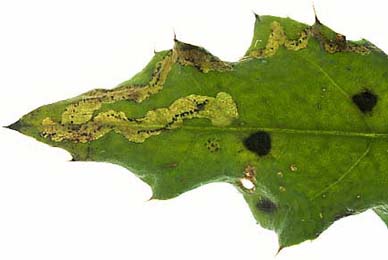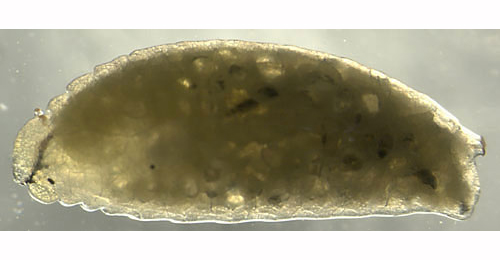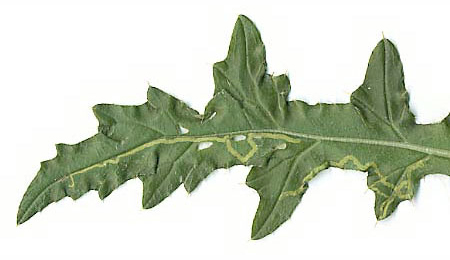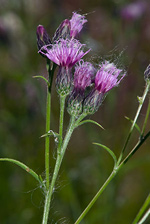|
||||||
|
SERRATULA. Saw-wort. [Asteraceae] |
|
|
Only one species of Serratula is recorded in Britain - the native Saw-wort (S. tinctoria). Nine or ten British miners are recorded on Serratula. A key to the European miners recorded on Serratula is provided in Bladmineerders van Europa. |
|
Key for the identification of the known mines of British |
Note: Diptera larvae may live in a corridor mine, a corridor-blotch mine, or a blotch mine, but never in a case, a rolled or folded leaf, a tentiform mine or sandwiched between two more or less circular leaf sections in later instars. Pupation never in a cocoon. All mining Diptera larvae are leg-less maggots without a head capsule (see examples). They never have thoracic or abdominal legs. They do not have chewing mouthparts, although they do have a characteristic cephalo-pharyngeal skeleton (see examples), usually visible internally through the body wall. The larvae lie on their sides within the mine and use their pick-like mouthparts to feed on plant tissue. In some corridor miners frass may lie in two rows on alternate sides of the mine. In order to vacate the mine the fully grown larva cuts an exit slit, which is usually semi-circular (see Liriomyza huidobrensis video). The pupa is formed within the hardened last larval skin or puparium and as a result sheaths enclosing head appendages, wings and legs are not visible externally (see examples). See Key to non-Diptera. |
1a > Leaf-miner: Mine linear, whitish, both upper and lower surface. Pupation internal, at the end of the mine with the anterior spiracles projecting through the epidermis (Spencer, 1976: 433). Upper-surface, less often lower-surface corridor. Frass in isolated grains. Pupation within the mine, in a, usually lower-surface, pupal chamber. A long whitish upper surface corridor, which eventually goes lower surface. |
|
Chromatomyia
horticola (Goureau, 1851) [Diptera: Agromyzidae] |
1b > Leaf-miner: A shallow, upper surface, whitish linear mine. Pupation external (Spencer, 1972b: 72 (fig. 233A), 77). Tortuous, upper-surface corridor, often somewhat geryish, and/or following the leaf margin. Frass grains fairly small, separated by about their own diameter. Primary feeding lines often conspicuous. Pupation outside the mine; exit slit in upper epidermis. A long whitish upper surface mine. The frass grains are small and can occur close together. |
 Mine of Phytomyza cirsii on Cirsium arvense Image: © Willem Ellis (Bladmineerders van Europa) |
 Phytomyza cirsii larva, lateral Image: © Willem Ellis (Bladmineerders van Europa) |
|
Phytomyza cirsii Hendel, 1923 [Diptera: Agromyzidae]. |
1c > Leaf-miner: Long narrow interparenchymal mine, greenish. Pupation in leaf at end of mine (Spencer, 1976: 503 (fig. 880)). Unusually long, interparenchymatous, therefore yellowish corridor that remains of equal width throughout its length. (In some plants with thin leaves, like Cirsium oleraceum the mines are not interparechymatous but either full-depth or alternating upper- and lower-surface). The mine makes few curves, and hardly any u-turn, causing the mine to usually occupy the entire length of a leaf. Frass in two rows of grains along the sides. Pupation within the mine, in a lower-surface puparial chamber; the anterior spiracles penetrate the epidermis. |
 Mines of Phytomyza spinaciae on Cirsium arvense Image: © Willem Ellis (Bladmineerders van Europa) |
|
Phytomyza spinaciae Hendel, 1928 [Diptera: Agromyzidae]. |
|
Key for the identification of the known mines of British |
Note: The larvae of mining Coleoptera, Hymenoptera and Lepidoptera may live in a corridor mine, a corridor-blotch mine, a blotch mine, a case, a rolled or folded leaf, a tentiform mine or sandwiched between two more or less circular leaf sections in later instars. Larva may pupate in a silk cocoon. The larva may have six legs (although they may be reduced or absent), a head capsule and chewing mouthparts with opposable mandibles (see video of a gracillarid larva feeding). Larvae of Hymenoptera and Lepidoptera usually also have abdominal legs (see examples). Frass, if present, never in two rows. Unless feeding externally from within a case the larva usually vacates the mine by chewing an exit hole. Pupa with visible head appendages, wings and legs which lie in sheaths (see examples). |
1a > Leaf-miner and case-bearer: The larva lives outside the mine, protected by a case, and feeds on the underlying plant tissues via a hole cut in the epidermis. From that point it eats away as much leaf tissue as it can reach without fully entering the mine. Mine does not contain frass (Coleophora species) |
1b > Leaf-miner, but not a case-bearer: The larva lives mainly inside the mine. Mine usually contains frass. In later instars the larva may live sandwiched between two more or less circular sections cut from the leaf. |
2a > Leaf-miner and case-bearer: Larva mines leaves. The larva builds a case from silk, resembling a razor shell in appearance.. The full-grown case is 12 mm long and blackish-brown. The full grown larva lives in a blackish brown trivalved tubular silken case of about 8 mm. |
|
Coleophora paripennella Zeller, 1839 [Lepidoptera: Coleophoridae]. |
3a > Leaf-miner: Short, gradually widening, brown, corridor, 9-13 mm long and 0.5-2 mm wide. At he start of the mine a small lower-surface hole, lined with silk, through which frass is ejected. The older larva lives free in a spinning under the leaf or, even later, in a leaf that is spun upwards into a pod. |
|
Agonopterix kuznetzovi Lvovsky, 1983 [Lepidoptera: Depressariidae]. |
3b > Leaf-miner: The eggs of this species are laid on a leaf, with the larvae mining the underside of the leaf, until a late instar when it feeds in a web under the midrib of the leaf, causing visible blotching on the upperside. Short, full depth corridor. The larva relatively long lives as a miner, but finally leaves the mine and continues living in spinning along the midrib at the leaf underside, from where windows are eaten in the leaf. |
 Mines of Agonopterix propinquella on Cirsium arvense Image: © Ian Smith (UKMoths) |
|
Agonopterix propinquella (Treitschke, 1835) [Lepidoptera: Depressariidae]. |
3c > Leaf-miner: In the first instar the larva mines the leaves, forming short, irregular, blotch-like mines, but in later instars it lives externally, feeding in spun leaves and often twisting those of tender shoots. Larval head light-brown or yellowish brown, edged with black postero-laterally, ocellar area blackish; prothoracic plate black edged with whitish anteriorly; abdomen dull dark green; pinacula distinct, black, sometimes brownish but with black bases to setae; anal plate large, black (Bradley et al., 1973). Small, full depth mine without a definite shape; little frass. Some silk is deposited in the mine. The larva soon leaves the mine and continues feeding among spun leaves. |
|
Cnephasia incertana (Treitschke, 1835) [Lepidoptera: Tortricidae]. |
3d > Long corridor, often following the leaf margin, with little frass and with the sides irrregularly eaten out. The first part of the corridor is full depth and makes a few close loops; the later part is more upper-surface and rather wide. Primary feeding lines often conspicuous. No morphological differences are known between the larva of S. rubidum and S. testaceum (Steinhausen, 1994a). However, there is a phenological difference: the larva of testaceum hibernates in the mine and continues feeding after winter; S. rubidum vacates the mine before winter and pupates in the soil. Hering (1957a) suggests that the identification of the beetles is an easy matter, but that is contradicted by Warchalowski (2003a). |
|
Sphaeroderma testaceum (Fabricius, 1775) [Coloeptera : Chrysomelidae] |
3e> Long corridor mine, without obvious relation with the leaf margin, with little frass and irregularly eaten out sides. The first part of the mine is full depth and makes a few close loops; the second part is upper-surface and considerably wider. Primary feedings lines often obvious. The larva is so broad that is completely fills the mine. No morphological differences are known between the larvae of S. rubidum and those of S. testaceum (Steinhausen, 1994a). The larva leaves the mine to pupate in the soil (the larva of testaceum hibernates in the mine.) Hering (1957a) suggests that the imagines are easily separated, but this is contradicted by Warchalowski (2003a). |
|
Sphaeroderma rubidum (Graells, 1858) [Coloeptera : Chrysomelidae] |
| Last updated 07-Jul-2019 Brian Pitkin | ||

